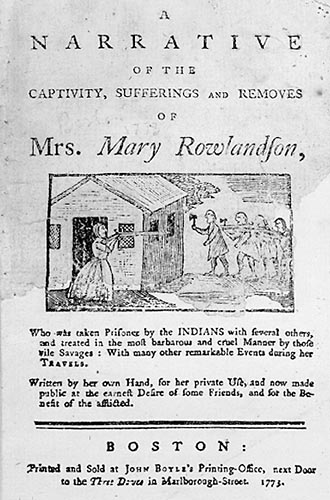|
 |
 |
 |
| Mary Rowlandson |
| �����Eù���� |
| �Ϥ��ӷ��GCover of first edition, showing Mary shooting a musket |
| �D�n�����GOthers |
| ��ƴ��Ѫ̡GMargarette Connor; Ron Tranquilla; Kate Liu
|
| ����r���GEarly American Women Writers: Voices in the Wilderness;Early American Literature;American Literature Survey I |
|
|
|
|
Mary Rowlandson |
|
Provider
: Margarette Connor |
| |
Earliest woman prose writer of note is Mary
Rowlandson, a minister's wife who gives a clear, moving account of her
11-week captivity by Indians during an Indian massacre in 1676.
She only wrote the one work, The Narrative of the Captivity and Restoration
of Mrs. Mary Rowlandson, but it was a very important work in terms of
popularity. It was an early best seller. It also helped fan anti-Native
American sentiment.
Born in England. With her parents John and
Joan White, she sailed for Salem in 1639
Joseph Rowlandson became a minister in 1654
and two years later he and Mary were married
They had a child, Mary, who lived for three
years; their other children were Joseph, Mary, Sarah. At the time of their
capture, the children were 14, 10, and 6.
In 1675 Joseph Rowlandson went to Boston
to beg for help from the Massachusetts General Assembly, during which
period Mary was captured. After she was freed by the Native Americans,
the couple lived in Boston and then moved in 1677 to Wethersfield, Connecticut.
While a prisoner, Mary Rowlandson travelled some 150 miles, and met with
King Philip/Metacomet himself, sachem of the Wampanoags.
Rowlandson has a clear Puritan agenda when she's writing. As she writes
at the beginning of her narrative:
"The sovereignty and goodness of GOD, together with the faithfulness
of his promises displayed, being a narrative of the captivity and restoration
of Mrs. Mary Rowlandson, commended by her, to all that desires to know
the Lord's doings to, and dealings with her."
What is disturbing for modern readers is way the Indians go back and forth
between being human in her eyes. The contrast between how she is so devastated
when her child dies but completely unmoved when the Indian children die,
and cannot fathom why the Indian mothers are so angry and easily riled
after their children's funerals can be shocking. But with all her historical
prejudices, it is still an important document and an important piece of
writing. |
| |
|
|
|
|
|
